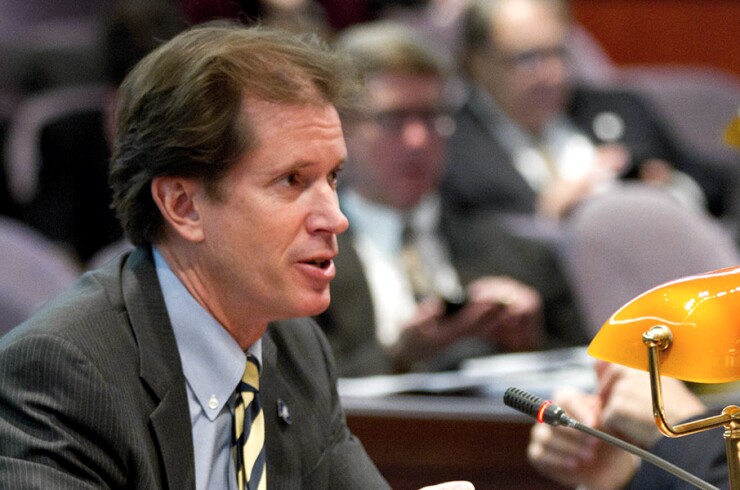The finding that more than 300 Connecticut bridges are structurally deficient has added another layer of agita to a state with budget strife, high legacy costs and political turmoil.
A

Further delaying the bridge fixes will make them even more expensive, according to TRIP.
The study could also trigger renewed debate over the resumption of tolling on Connecticut’s highways.
“In my opinion, Connecticut has no choice but to find a way to finance this,” said Alan Schankel, a managing director at Janney Capital Markets.
Connecticut discontinued tolling in the mid-1980s. In recent years, the matter has become a political third rail. Efforts to reinstitute tolls during the past two years have fallen short. Lame-duck Gov. Dannel Malloy, a Democrat, commissioned a $10 million study on tolling.
In July, the state Bond Commission approved the toll study by a 6-3 vote with one abstention, one of the rare non-unanimous approvals by the panel.
“Tolling is one idea that's probably going to get some support,” said Schankel. “Tolling hits the users, which is an easier sell. There are other revenue-raising solutions, too, including raising taxes or taxes related to transportation.”
Tolling or not, financing infrastructure repair amid budget strain could vex the new governor and General Assembly in January. The state’s direction will hinge on the open-seat race for governor and the makeup of the legislature, where the Senate is now split 18-18 and the Democrats hold an 80-71 edge in the House of Representatives.
Republican gubernatorial candidate Mark Stefanowski and other GOP leaders oppose tolling, while his Democratic opponent, Ned Lamont, favors a truck-only system that Rhode Island adopted.
Rhode Island faces a legal challenge in federal court over its enabling law.
“To retain businesses, accommodate population and economic growth, maintain economic competitiveness and achieve further economic growth, Connecticut will need to maintain and modernize its bridges by repairing or replacing deficient bridges and providing needed maintenance on other bridges to ensure that they remain in good condition as long as possible,” said the TRIP report.
“Making needed improvements to Connecticut’s bridges will require increased and reliable funding from local, state and federal governments, which will also provide a significant boost to the state’s economy by creating jobs in the short term and stimulating long term economic growth as a result of preserved and enhanced mobility and access.”
Moody’s Investors Service rates Connecticut A1, while S&P Global Ratings and Fitch Ratings rate the GOs A and A-plus, respectively. Kroll Bond Ratings Agency assigns its AA-minus rating. Kroll assigns a negative outlook, the others stable.
Bill Glasgall, senior vice president of the nonprofit Volcker Alliance, called deferred infrastructure “probably the biggest [national] crisis of them all.”

Speaking Sept. 17 at a Chicago conference sponsored by the Volcker Alliance and the Federal Reserve Bank of Chicago, Glasgall said it’s “bigger than pensions, bigger than education … It’s the subway that’s not arriving, it’s the highway that’s falling down. We don’t know how to pay for it, we don’t even know how to measure it.”
Connecticut bears the searing memory of the Mianus River Bridge collapse in June 1983, when a section of the bridge on Interstate 95 in Greenwich collapsed, killing three people and injuring three others. The time of the accident, 1:30 a.m., minimized the casualties.
The
Many of the bridges TRIP identified as structurally deficient are on Connecticut's Interstate highways. The busiest, on I-95 in Norwalk, carries 145,000 vehicles daily.
“As someone who lived through the Mianus River bridge collapse in 1983 and the multiple year reconstruction, I can tell you that we cannot afford to have this kind of catastrophe ever again,” said state Sen. Scott Frantz, R-Greenwich.
“Had the special transportation fund been supported over the last 10 years, we would not face the remote potential of over 300 bridges failing of our over 4,000 bridges. This highlights the need for a genuine ‘lockbox’ for transportation purposes is paramount.”
A ballot initiative calling for transportation lockbox will go before voters in November.
Malloy has
Malloy’s $30-year, $100 billion transportation improvement initiative has stalled. A Republican plan calls for $60 billion in infrastructure improvements the same period without tolling,
The GOP accused Malloy of bonding for pork projects on his way out of office.
“While our bridges and infrastructure decay, Gov. Malloy has been maxing out the state’s credit card to pay for a splash pad, little league fields, handball courts, a grocery store and a $10 million tolls study,” said state Sen. Len Fasano, R-North Haven.





